Phonopy in pyiron¶
We will use the quasi-harmonic approximation (via PyIron’s implementation of the popular phonopy package) to evaluate look at thermal expansion and self-diffusion in Aluminium
[1]:
# Generic imports
from pyiron import Project
import numpy as np
%matplotlib inline
import matplotlib.pylab as plt
import seaborn as sns
[2]:
pr = Project("PhonopyExample")
pot = '2009--Mendelev-M-I--Al-Mg--LAMMPS--ipr1'
Helper functions¶
Because repeating code is evil.
[3]:
def make_phonopy_job(template_job, name):
"""
Create a phonopy job from a reference job.
Args:
template_job (pyiron job): The job to copy.
name (str): What to call this new job.
Returns:
A new phonopy job.
"""
project = template_job.project
# What I want:
# job_type = template_job.job_type
# What I have to do instead:
job_type = pr.job_type.Lammps
ref = project.create_job(job_type, name + "_ref")
ref.structure = template_job.get_final_structure().copy()
ref.potential = template_job.potential
phono = project.create_job(pr.job_type.PhonopyJob, name)
phono.ref_job = ref
return phono
[4]:
def scale_array(arr, scaler=None, new_range=1.):
"""
Linearly transforms an array so that values equal to the minimum and maximum of the
`scaler` array are mapped to the range (0, `new_range`). Note that rescaled values can
still lie outside this range if the orignal values of `arr` are outside the bounds of
`scaler`.
Args:
arr (np.array): Array to rescale.
scaler (np.array): Array by which to rescale. Default is `arr`.
new_range (float): New value for data which was the size `np.amax(scaler)`.
Default is 1.
"""
if scaler is None:
scaler = arr
return new_range * (arr - np.amin(scaler)) / np.ptp(scaler)
Thermal Expansion¶
What does the QHA say the lattice constant is as a function of temperature?
[5]:
pr_te = pr.create_group("ThermalExpansion")
Relax the unit cell¶
If we were doing VASP instead it would be important to do the least computation as possible, so here we’ll start by relaxing a simple unit cell to turn into a supercell later.
[6]:
job_unit = pr_te.create_job(pr.job_type.Lammps, "UnitCell")
[7]:
basis = pr_te.create_structure("Al", "fcc", 4.04)
[8]:
job_unit.structure = basis
job_unit.potential = pot
[9]:
job_unit.calc_minimize(pressure=0.0)
job_unit.run()
The job UnitCell was saved and received the ID: 8886147
[10]:
basis_rel = job_unit.get_final_structure()
Relax the bulk supercell¶
A relaxation which should take zero steps given our starting position!
[11]:
job_bulk_1 = pr_te.create_job(pr.job_type.Lammps, "Bulk_1")
# The _1 here refers to the fact that the volume has been rescaled by a factor of "1.0"
# (i.e. it hasn't been rescaled)
[12]:
n_reps = 3
job_bulk_1.structure = basis_rel.repeat(rep=n_reps)
job_bulk_1.potential = pot
[13]:
job_bulk_1.structure.plot3d();
[14]:
job_bulk_1.calc_minimize(pressure=0.0)
job_bulk_1.run()
The job Bulk_1 was saved and received the ID: 8886148
Calculate phonons¶
Run phonopy on the bulk supercell
[15]:
phono_bulk_1 = make_phonopy_job(job_bulk_1, "PhonoBulk_1")
[16]:
phono_bulk_1.run()
# Run performs a whole bunch of child calculations
# Each one has the positions slightly deformed in the symmetry-appropriate ways needed
# to get the phonon properties
The job PhonoBulk_1 was saved and received the ID: 8886149
The job supercell_phonon_0 was saved and received the ID: 8886150
[17]:
# Let's see what we got...
T_min = 0
T_max = 800 # a bit below melting
T_step = 25
temperatures = np.linspace(T_min, T_max, int((T_max - T_min) / T_step))
tp_bulk_1 = phono_bulk_1.get_thermal_properties(temperatures=temperatures)
# `get_thermal_properties` uses the displacements and forces to generate phonon information
[18]:
U_bulk_1 = job_bulk_1.output.energy_pot[-1]
Fvib_bulk_1 = tp_bulk_1.free_energies
plt.plot(temperatures, U_bulk_1 + Fvib_bulk_1)
plt.xlabel("Temperature [K]")
plt.ylabel("Free energy ($U+F_{vib}$) [eV]")
[18]:
Text(0, 0.5, 'Free energy ($U+F_{vib}$) [eV]')
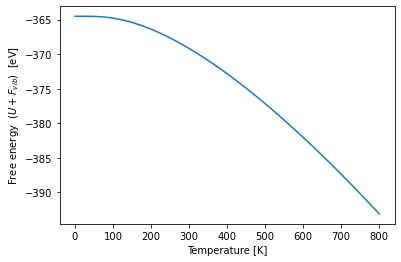
Calculate thermal expansivity¶
Above we have the (QHA approximation to the) free energy as a function of temperature at a fixed volume. To evaluate the thermal expansivity, we need to create the entire F(V,T) surface. To get this, we just loop over jobs like the above, but scaled to have different lattice constants.
[19]:
# According to Wikipedia, the thermal expansivity is about 0.0023% / Kelvin
# So at our maximum temperature, we expect around 1.8% expansion
scale_min = -0.005
scale_max = 0.02
scale_step = 0.002
scales = np.linspace(scale_min, scale_max, int((scale_max - scale_min) / scale_step))
[20]:
# Let's keep things clean by making another sub-directory
pr_scales = pr_te.create_group("ScanScales")
[21]:
# Loop the phonon calculation over all the volumes
sc_bulk_rel = job_bulk_1.get_final_structure()
bulk_free_energies = np.zeros((len(scales), len(temperatures)))
for i, scale in enumerate(scales):
name_tail = "_{}".format(str(scale).replace(".", "c").replace('-', 'm'))
# Make a bulk job with the rescaled structure
# (already relaxed, by symmetry won't change, calc static will be enough)
job_bulk = pr_scales.create_job(pr.job_type.Lammps, "Bulk" + name_tail)
job_bulk.potential = pot
job_bulk.structure = sc_bulk_rel.apply_strain(epsilon=scale, return_box=True)
job_bulk.calc_static()
job_bulk.run()
U = job_bulk.output.energy_tot[-1]
# Use that job as a reference for a phonopy job
phono_bulk = make_phonopy_job(job_bulk, "PhonoBulk" + name_tail)
phono_bulk.run()
tp_bulk = phono_bulk.get_thermal_properties(temperatures=temperatures)
Fvib = tp_bulk.free_energies
# Fill in the row of free energies for this volume
bulk_free_energies[i] = Fvib + U
The job Bulk_m0c005 was saved and received the ID: 8886151
The job PhonoBulk_m0c005 was saved and received the ID: 8886152
The job supercell_phonon_0 was saved and received the ID: 8886153
The job Bulk_m0c002727272727272727 was saved and received the ID: 8886154
The job PhonoBulk_m0c002727272727272727 was saved and received the ID: 8886155
The job supercell_phonon_0 was saved and received the ID: 8886156
The job Bulk_m0c000454545454545454 was saved and received the ID: 8886157
The job PhonoBulk_m0c000454545454545454 was saved and received the ID: 8886158
The job supercell_phonon_0 was saved and received the ID: 8886159
The job Bulk_0c0018181818181818186 was saved and received the ID: 8886160
The job PhonoBulk_0c0018181818181818186 was saved and received the ID: 8886161
The job supercell_phonon_0 was saved and received the ID: 8886162
The job Bulk_0c004090909090909092 was saved and received the ID: 8886163
The job PhonoBulk_0c004090909090909092 was saved and received the ID: 8886164
The job supercell_phonon_0 was saved and received the ID: 8886165
The job Bulk_0c006363636363636366 was saved and received the ID: 8886166
The job PhonoBulk_0c006363636363636366 was saved and received the ID: 8886167
The job supercell_phonon_0 was saved and received the ID: 8886168
The job Bulk_0c008636363636363636 was saved and received the ID: 8886169
The job PhonoBulk_0c008636363636363636 was saved and received the ID: 8886170
The job supercell_phonon_0 was saved and received the ID: 8886171
The job Bulk_0c01090909090909091 was saved and received the ID: 8886172
The job PhonoBulk_0c01090909090909091 was saved and received the ID: 8886173
The job supercell_phonon_0 was saved and received the ID: 8886174
The job Bulk_0c013181818181818183 was saved and received the ID: 8886175
The job PhonoBulk_0c013181818181818183 was saved and received the ID: 8886176
The job supercell_phonon_0 was saved and received the ID: 8886177
The job Bulk_0c015454545454545457 was saved and received the ID: 8886178
The job PhonoBulk_0c015454545454545457 was saved and received the ID: 8886179
The job supercell_phonon_0 was saved and received the ID: 8886180
The job Bulk_0c01772727272727273 was saved and received the ID: 8886182
The job PhonoBulk_0c01772727272727273 was saved and received the ID: 8886183
The job supercell_phonon_0 was saved and received the ID: 8886184
The job Bulk_0c02 was saved and received the ID: 8886186
The job PhonoBulk_0c02 was saved and received the ID: 8886187
The job supercell_phonon_0 was saved and received the ID: 8886188
[22]:
# The lattice constant is probably a more informative value than the 0K-relative strain
latts = basis_rel.cell[0][0] * scales
[23]:
# At each temperature, find the optimal volume by a simple quadratic fit
# ...Wait, which order fit will be good enough? Let's just spot-check
free_en = bulk_free_energies[:, -1]
plt.plot(latts, free_en, color='b', label='data')
# We'll plot the fit on a much denser mesh
fit_deg = 4
p = np.polyfit(latts, free_en, deg=fit_deg)
dense_latts = np.linspace(np.amin(latts), np.amax(latts), 1000)
#dense_latts = np.linspace(0, 10, 1000)
plt.plot(dense_latts, np.polyval(p=p, x=dense_latts), color='r', label='fit')
plt.xlabel('Lattice constant [$\mathrm{\AA}$]')
plt.ylabel('Bulk free energy [eV/supercell]')
plt.legend()
# Ok, a fourth-order fit seems perfectly reasonable
[23]:
<matplotlib.legend.Legend at 0x2b151bd2ac10>
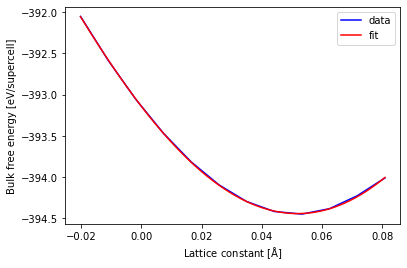
[24]:
# Now find optimal temperatures
best_latts = np.zeros(len(temperatures))
best_latt_guess = basis_rel.cell[0][0]
for i, T in enumerate(temperatures):
free_en = bulk_free_energies[:, i]
p = np.polyfit(latts, free_en, deg=fit_deg)
extrema = np.roots(np.polyder(p, m=1)).real # Find where first-derivative is zero
best_latts[i] = extrema[np.argmin(np.abs(extrema - best_latt_guess))]
[25]:
# Check that they're resonable
print(best_latt_guess, '\n', best_latts)
4.045270475668763
[0.11555233 0.11352406 0.10694882 0.10163624 0.09885196 1.43573459
0.77014253 0.60322527 0.51918649 0.46683335 0.43047109 0.40346556
0.38247104 0.36559688 0.35168556 0.33998477 0.32998232 0.32131628
0.31372298 0.30700538 0.30101301 0.29562879 0.29076015 0.28633285
0.28228657 0.2785718 0.27514744 0.27197909 0.2690377 0.26629857
0.26374056 0.26134543]
[26]:
# Let's look at the landscape
fig, ax = plt.subplots()
sns.heatmap(bulk_free_energies, ax=ax, cmap="coolwarm",
xticklabels=['{:,.0f}'.format(T) for T in temperatures],
yticklabels=['{:,.2f}'.format(a) for a in latts])
ax.set_xlabel("Temperature [K]")
ax.set_ylabel("Lattice constant [$\mathrm{\AA}$]")
# Overlaying the optimal path takes a couple changes of variables
# since the heatmap is plotting integer cells
ax.plot(scale_array(temperatures, new_range=len(temperatures)),
scale_array(best_latts, scaler=latts, new_range=len(latts)),
color='k')
[26]:
[<matplotlib.lines.Line2D at 0x2b1519223a90>]
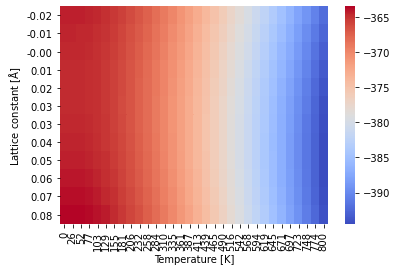
Vacancies and diffusion¶
Another common use of QHA is to calculate the pre-factor for migration in a diffusion event.
In particular, the diffusion jump barrier looks like \(\omega_0 = \nu_0^\star \exp(-H_\mathrm{m} / k_\mathrm{B} T)\), where \(\nu_0^\star = \prod_{i=1}^{3N-3} \nu_i^\mathrm{IS} / \prod_{i=1}^{3N-4} \nu_i^\mathrm{TS}\), with IS and TS indicating the initial and transition states, respectively. Note that the transition state is missing a single frequency, which is from the instability of the transition state. It’s either an imaginary mode, which I think means a negative frequency. Meanwhile, \(H_\mathrm{m}\) is the enthalpic barrier (difference between the initial and transition states) and \(k_\mathrm{B} T\) is the usual thermal energy term.
Typically, these sorts of investigations use the nudged elastic band (NEB) to find the 0K transition state. You can do that with our new flexible jobs, but we’ll save that for later. For now we’ll just “approximate” the transition state with a simple linear interpolation.
Stable vacancy structures¶
Let’s start by generating and relaxing the initial and final states
[27]:
pr_vac = pr.create_group("Vacancies")
[28]:
# Find two adjacent sites
print(job_bulk_1.structure.positions[0])
print(job_bulk_1.structure.positions[1])
# Yep, 1 and 2 will do
[0. 0. 0.]
[ 2.02263524e+00 2.02263524e+00 -7.63052415e-33]
[29]:
job_vac_i = pr_vac.create_job(pr.job_type.Lammps, "VacancyInitial")
job_vac_f = pr_vac.create_job(pr.job_type.Lammps, "VacancyFinal")
job_vac_i.potential = pot
job_vac_f.potential = pot
[30]:
sc_vac_i = sc_bulk_rel.copy()
sc_vac_i.pop(0)
job_vac_i.structure = sc_vac_i
sc_vac_f = sc_bulk_rel.copy()
sc_vac_f.pop(1)
job_vac_f.structure = sc_vac_f
[31]:
# Relax the new vacancy structures
job_vac_i.calc_minimize(pressure=0.0)
job_vac_i.run()
job_vac_f.calc_minimize(pressure=0.0)
job_vac_f.run()
The job VacancyInitial was saved and received the ID: 8886189
The job VacancyFinal was saved and received the ID: 8886190
DOS¶
The pyiron implementation of phonopy makes it very easy to look at the DOS. Let’s see what the effect is of introducing a vacancy, and confirm that our two vacancies are equivalent.
[32]:
phon_vac_i = make_phonopy_job(job_vac_i, "PhonoVacInitial")
phon_vac_f = make_phonopy_job(job_vac_f, "PhonoVacFinal")
[33]:
phon_vac_i.run()
tp_vac_i = phon_vac_i.get_thermal_properties(temperatures=temperatures)
phon_vac_f.run()
tp_vac_f = phon_vac_i.get_thermal_properties(temperatures=temperatures)
# Note that the vacancy structures spawn many more child processes
# This is because the vacancy structure has lower symmetry
The job PhonoVacInitial was saved and received the ID: 8886191
The job supercell_phonon_0 was saved and received the ID: 8886192
The job supercell_phonon_1 was saved and received the ID: 8886193
The job supercell_phonon_2 was saved and received the ID: 8886194
The job supercell_phonon_3 was saved and received the ID: 8886195
The job supercell_phonon_4 was saved and received the ID: 8886196
The job supercell_phonon_5 was saved and received the ID: 8886197
The job supercell_phonon_6 was saved and received the ID: 8886198
The job supercell_phonon_7 was saved and received the ID: 8886199
The job supercell_phonon_8 was saved and received the ID: 8886200
The job supercell_phonon_9 was saved and received the ID: 8886201
The job supercell_phonon_10 was saved and received the ID: 8886202
The job supercell_phonon_11 was saved and received the ID: 8886203
The job supercell_phonon_12 was saved and received the ID: 8886204
The job supercell_phonon_13 was saved and received the ID: 8886205
The job supercell_phonon_14 was saved and received the ID: 8886207
The job supercell_phonon_15 was saved and received the ID: 8886208
The job supercell_phonon_16 was saved and received the ID: 8886209
The job supercell_phonon_17 was saved and received the ID: 8886210
The job supercell_phonon_18 was saved and received the ID: 8886211
The job supercell_phonon_19 was saved and received the ID: 8886212
The job supercell_phonon_20 was saved and received the ID: 8886213
The job PhonoVacFinal was saved and received the ID: 8886214
The job supercell_phonon_0 was saved and received the ID: 8886215
The job supercell_phonon_1 was saved and received the ID: 8886216
The job supercell_phonon_2 was saved and received the ID: 8886217
The job supercell_phonon_3 was saved and received the ID: 8886218
The job supercell_phonon_4 was saved and received the ID: 8886219
The job supercell_phonon_5 was saved and received the ID: 8886220
The job supercell_phonon_6 was saved and received the ID: 8886221
The job supercell_phonon_7 was saved and received the ID: 8886222
The job supercell_phonon_8 was saved and received the ID: 8886223
The job supercell_phonon_9 was saved and received the ID: 8886225
The job supercell_phonon_10 was saved and received the ID: 8886226
The job supercell_phonon_11 was saved and received the ID: 8886227
The job supercell_phonon_12 was saved and received the ID: 8886228
The job supercell_phonon_13 was saved and received the ID: 8886229
The job supercell_phonon_14 was saved and received the ID: 8886230
The job supercell_phonon_15 was saved and received the ID: 8886231
The job supercell_phonon_16 was saved and received the ID: 8886232
The job supercell_phonon_17 was saved and received the ID: 8886233
The job supercell_phonon_18 was saved and received the ID: 8886234
The job supercell_phonon_19 was saved and received the ID: 8886235
The job supercell_phonon_20 was saved and received the ID: 8886236
[34]:
fig, ax = plt.subplots()
phono_bulk_1.plot_dos(ax=ax, color='b', label='bulk')
phon_vac_i.plot_dos(ax=ax, color='r', label='vac_i')
phon_vac_f.plot_dos(ax=ax, color='orange', label='vac_f')
plt.legend()
[34]:
<matplotlib.legend.Legend at 0x2b157cd72890>
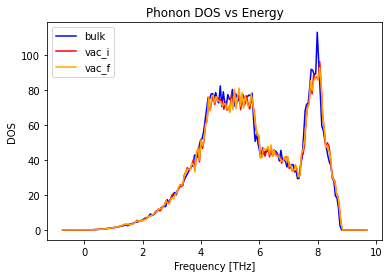
Attempt frequency¶
Now we get the attempt frequency by comparing the individual phonon spectra of initial and transition states
[35]:
# Interpolate initial and final positions to guesstimate the transition state
sc_vac_ts = sc_vac_i.copy()
sc_vac_ts.positions = 0.5 * (sc_vac_i.positions + sc_vac_f.positions)
[36]:
job_vac_ts = pr_vac.create_job(pr.job_type.Lammps, "VacancyTransition")
job_vac_ts.potential = pot
job_vac_ts.structure = sc_vac_ts
[37]:
# We _don't_ relax this job, or it would fall into the initial or final state!
job_vac_ts.calc_static()
job_vac_ts.run()
The job VacancyTransition was saved and received the ID: 8886237
[38]:
phon_vac_ts = make_phonopy_job(job_vac_ts, "PhonoVacTransition")
[39]:
phon_vac_ts.run()
tp_vac_ts = phon_vac_ts.get_thermal_properties(temperatures=temperatures)
The job PhonoVacTransition was saved and received the ID: 8886238
The job supercell_phonon_0 was saved and received the ID: 8886239
The job supercell_phonon_1 was saved and received the ID: 8886240
The job supercell_phonon_2 was saved and received the ID: 8886241
The job supercell_phonon_3 was saved and received the ID: 8886242
The job supercell_phonon_4 was saved and received the ID: 8886243
The job supercell_phonon_5 was saved and received the ID: 8886244
The job supercell_phonon_6 was saved and received the ID: 8886245
The job supercell_phonon_7 was saved and received the ID: 8886246
The job supercell_phonon_8 was saved and received the ID: 8886247
The job supercell_phonon_9 was saved and received the ID: 8886248
The job supercell_phonon_10 was saved and received the ID: 8886249
The job supercell_phonon_11 was saved and received the ID: 8886250
The job supercell_phonon_12 was saved and received the ID: 8886251
The job supercell_phonon_13 was saved and received the ID: 8886252
The job supercell_phonon_14 was saved and received the ID: 8886253
The job supercell_phonon_15 was saved and received the ID: 8886254
The job supercell_phonon_16 was saved and received the ID: 8886255
The job supercell_phonon_17 was saved and received the ID: 8886256
The job supercell_phonon_18 was saved and received the ID: 8886257
The job supercell_phonon_19 was saved and received the ID: 8886258
The job supercell_phonon_20 was saved and received the ID: 8886259
The job supercell_phonon_21 was saved and received the ID: 8886260
The job supercell_phonon_22 was saved and received the ID: 8886261
The job supercell_phonon_23 was saved and received the ID: 8886262
The job supercell_phonon_24 was saved and received the ID: 8886263
The job supercell_phonon_25 was saved and received the ID: 8886264
The job supercell_phonon_26 was saved and received the ID: 8886265
The job supercell_phonon_27 was saved and received the ID: 8886267
The job supercell_phonon_28 was saved and received the ID: 8886269
The job supercell_phonon_29 was saved and received the ID: 8886270
The job supercell_phonon_30 was saved and received the ID: 8886271
The job supercell_phonon_31 was saved and received the ID: 8886272
The job supercell_phonon_32 was saved and received the ID: 8886273
The job supercell_phonon_33 was saved and received the ID: 8886274
The job supercell_phonon_34 was saved and received the ID: 8886275
The job supercell_phonon_35 was saved and received the ID: 8886276
The job supercell_phonon_36 was saved and received the ID: 8886277
The job supercell_phonon_37 was saved and received the ID: 8886278
The job supercell_phonon_38 was saved and received the ID: 8886279
The job supercell_phonon_39 was saved and received the ID: 8886280
The job supercell_phonon_40 was saved and received the ID: 8886281
The job supercell_phonon_41 was saved and received the ID: 8886282
The job supercell_phonon_42 was saved and received the ID: 8886283
The job supercell_phonon_43 was saved and received the ID: 8886284
The job supercell_phonon_44 was saved and received the ID: 8886285
The job supercell_phonon_45 was saved and received the ID: 8886286
The job supercell_phonon_46 was saved and received the ID: 8886287
The job supercell_phonon_47 was saved and received the ID: 8886288
The job supercell_phonon_48 was saved and received the ID: 8886289
The job supercell_phonon_49 was saved and received the ID: 8886290
The job supercell_phonon_50 was saved and received the ID: 8886291
The job supercell_phonon_51 was saved and received the ID: 8886292
The job supercell_phonon_52 was saved and received the ID: 8886293
The job supercell_phonon_53 was saved and received the ID: 8886294
The job supercell_phonon_54 was saved and received the ID: 8886295
The job supercell_phonon_55 was saved and received the ID: 8886296
The job supercell_phonon_56 was saved and received the ID: 8886297
The job supercell_phonon_57 was saved and received the ID: 8886298
The job supercell_phonon_58 was saved and received the ID: 8886299
The job supercell_phonon_59 was saved and received the ID: 8886300
The job supercell_phonon_60 was saved and received the ID: 8886301
The job supercell_phonon_61 was saved and received the ID: 8886302
The job supercell_phonon_62 was saved and received the ID: 8886303
The job supercell_phonon_63 was saved and received the ID: 8886304
The job supercell_phonon_64 was saved and received the ID: 8886305
The job supercell_phonon_65 was saved and received the ID: 8886306
The job supercell_phonon_66 was saved and received the ID: 8886307
The job supercell_phonon_67 was saved and received the ID: 8886308
The job supercell_phonon_68 was saved and received the ID: 8886309
The job supercell_phonon_69 was saved and received the ID: 8886310
The job supercell_phonon_70 was saved and received the ID: 8886311
The job supercell_phonon_71 was saved and received the ID: 8886312
The job supercell_phonon_72 was saved and received the ID: 8886313
The job supercell_phonon_73 was saved and received the ID: 8886314
The job supercell_phonon_74 was saved and received the ID: 8886315
The job supercell_phonon_75 was saved and received the ID: 8886316
The job supercell_phonon_76 was saved and received the ID: 8886317
The job supercell_phonon_77 was saved and received the ID: 8886318
The job supercell_phonon_78 was saved and received the ID: 8886319
The job supercell_phonon_79 was saved and received the ID: 8886320
The job supercell_phonon_80 was saved and received the ID: 8886321
The job supercell_phonon_81 was saved and received the ID: 8886322
The job supercell_phonon_82 was saved and received the ID: 8886323
The job supercell_phonon_83 was saved and received the ID: 8886324
The job supercell_phonon_84 was saved and received the ID: 8886325
The job supercell_phonon_85 was saved and received the ID: 8886326
The job supercell_phonon_86 was saved and received the ID: 8886327
The job supercell_phonon_87 was saved and received the ID: 8886328
The job supercell_phonon_88 was saved and received the ID: 8886329
The job supercell_phonon_89 was saved and received the ID: 8886330
The job supercell_phonon_90 was saved and received the ID: 8886331
The job supercell_phonon_91 was saved and received the ID: 8886332
The job supercell_phonon_92 was saved and received the ID: 8886333
The job supercell_phonon_93 was saved and received the ID: 8886334
The job supercell_phonon_94 was saved and received the ID: 8886335
[40]:
# The transition state has an imaginary mode (frequency < 0), let's see it
fig, ax = plt.subplots()
phon_vac_i.plot_dos(ax=ax, color='r', label='initial')
phon_vac_ts.plot_dos(ax=ax, color='b', label='transition')
plt.legend()
[40]:
<matplotlib.legend.Legend at 0x2b157c09cc90>
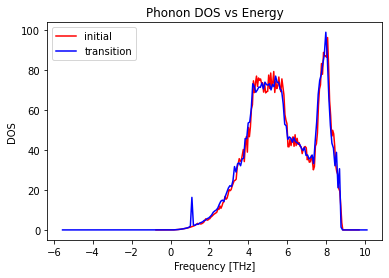
To calculate the attempt frequency, we’ll ignore both the negative mode of the transition state (which we were warned about in the equation), as well as the three frequencies which correspond to rigid translation and are very near zero, and sometimes dip to be negative. Phonopy sorts the frequencies by magnitude, so we can just skip the first three and four for the initial and transition states, respectively. We take them at q=0.
[41]:
freq_i = phon_vac_i.phonopy.get_frequencies(0)[3:]
freq_ts = phon_vac_i.phonopy.get_frequencies(0)[4:]
[42]:
print(np.prod(freq_i))
6.870293244293476e+236
Recall: \(\nu_0^\star = \prod_{i=1}^{3N-3} \nu_i^\mathrm{IS} / \prod_{i=1}^{3N-4} \nu_i^\mathrm{TS}\)
[43]:
# Products are dangerous beasts, so we'll do a little numeric magic
nu = np.prod(freq_i[:-1] / freq_ts) * freq_i[-1]
print("Attempt frequency is ", nu, "THz (10^-12 s)")
Attempt frequency is 2.6826762430167848 THz (10^-12 s)
Mantina et al. (PRL 2008) report \(\nu = 19.3\) THz using DFT and NEB, so our linearly-interpolated “transition state” with EAM is actually not doing so poorly.
There are many more things you can do with phonopy, including looking directly at the force constants, the Hessian matrix, etc. But hopefully this is a useful starting point.
[ ]: